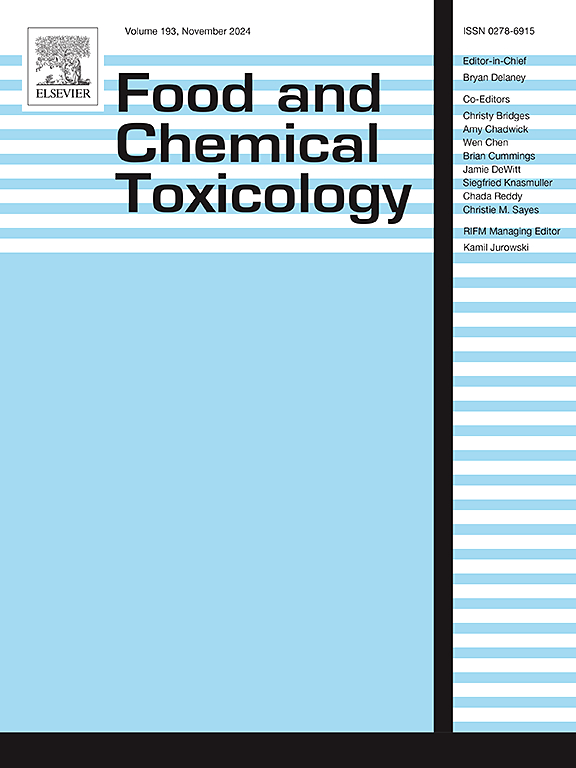Piceatannol upregulates USP14-mediated GPX4 deubiquitination to inhibit neuronal ferroptosis caused by cerebral ischemia-reperfusion in mice
IF 3.9
3区 医学
Q2 FOOD SCIENCE & TECHNOLOGY
引用次数: 0
Abstract
Ischemic stroke is a very common brain disorder. This study aims to assess the neuroprotective effects of piceatannol (PCT) in preventing neuronal injury resulting from cerebral ischemia and reperfusion (I/R) in mice. Additionally, we investigated the underlying mechanisms through which PCT inhibits neuronal ferroptosis by modulating the USP14/GPX4 signaling axis. In vitro and in vivo experiments were conducted. In vitro, oxygen-glucose deprivation followed by reoxygenation (OGD/R) was used to simulate ischemic injury in neuronal cells. We utilized various techniques, including DCFH-DA staining, FeRhoNox-1 staining, MDA and GSH determination, immunofluorescence, Western blotting, co-immunoprecipitation, plasmid and siRNA transfection, to evaluate the therapeutic efficacy of PCT and elucidate its mechanism of action. For vivo studies, we established a mouse model of I/R by ligating the bilateral common carotid arteries. The efficacy of PCT in mitigating brain injury and cognitive dysfunction were assessed through behavioral tests, histological analysis, Western blotting, and immunohistochemistry. PCT treatment significantly enhanced cell viability under OGD/R and reduced lipid peroxidation by decreasing levels of ROS, MDA. Furthermore, PCT effectively inhibited neuronal ferroptosis by modulating the expression of key ferroptosis-related proteins, including GPX4, ACSL4, FPN1, and Ferritin. Mechanistically, PCT was found to prevent GPX4 degradation through USP14-mediated deubiquitination. Notably, silencing USP14 reversed the ferroptotic effects of PCT, whereas overexpressing of USP14 amplified these effects. In vivo, PCT significantly reduced pathological damage of brain tissue and improved cognitive dysfunction. Piceatannol exerts neuroprotective effects by regulating ferroptosis through the USP14/GPX4 axis, thereby preventing cerebral ischemia/reperfusion injury.

求助全文
约1分钟内获得全文
求助全文
来源期刊

Food and Chemical Toxicology
工程技术-毒理学
CiteScore
10.90
自引率
4.70%
发文量
651
审稿时长
31 days
期刊介绍:
Food and Chemical Toxicology (FCT), an internationally renowned journal, that publishes original research articles and reviews on toxic effects, in animals and humans, of natural or synthetic chemicals occurring in the human environment with particular emphasis on food, drugs, and chemicals, including agricultural and industrial safety, and consumer product safety. Areas such as safety evaluation of novel foods and ingredients, biotechnologically-derived products, and nanomaterials are included in the scope of the journal. FCT also encourages submission of papers on inter-relationships between nutrition and toxicology and on in vitro techniques, particularly those fostering the 3 Rs.
The principal aim of the journal is to publish high impact, scholarly work and to serve as a multidisciplinary forum for research in toxicology. Papers submitted will be judged on the basis of scientific originality and contribution to the field, quality and subject matter. Studies should address at least one of the following:
-Adverse physiological/biochemical, or pathological changes induced by specific defined substances
-New techniques for assessing potential toxicity, including molecular biology
-Mechanisms underlying toxic phenomena
-Toxicological examinations of specific chemicals or consumer products, both those showing adverse effects and those demonstrating safety, that meet current standards of scientific acceptability.
Authors must clearly and briefly identify what novel toxic effect (s) or toxic mechanism (s) of the chemical are being reported and what their significance is in the abstract. Furthermore, sufficient doses should be included in order to provide information on NOAEL/LOAEL values.
 求助内容:
求助内容: 应助结果提醒方式:
应助结果提醒方式:


